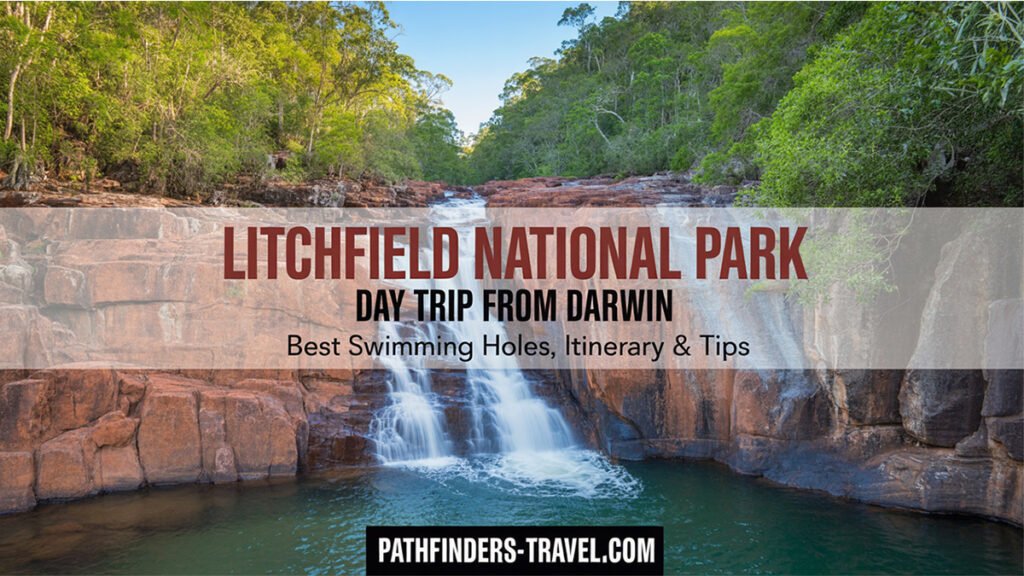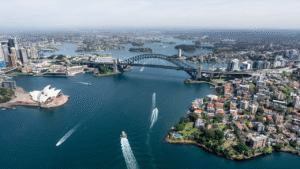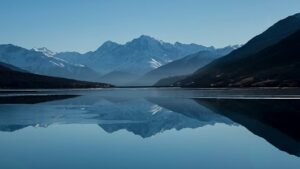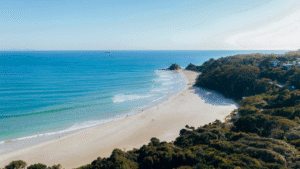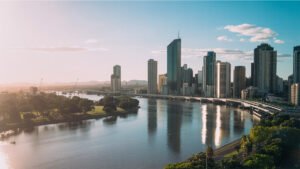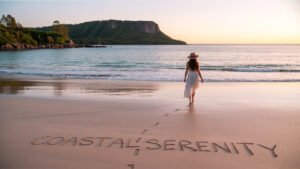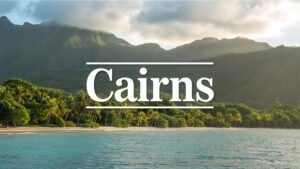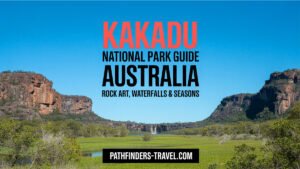Estimated reading time: 21 minutes
Key Takeaways
- Darwin serves as the perfect gateway to exploring Australia’s Top End, with Litchfield National Park just 90 minutes away
- Litchfield National Park offers spectacular swimming holes, including Florence Falls, Wangi Falls, and Buley Rockhole
- The dry season (May-September) provides the best conditions for swimming and exploring the park
- A day trip from Darwin allows enough time to see the main attractions, though staying longer lets you explore at a relaxed pace
- Both guided tours and self-drive options are available, making Litchfield accessible for all types of travelers
Table of Contents
- Introduction
- Overview of Darwin & the Top End
- Spotlight on Litchfield National Park
- Best Swimming Holes in Litchfield National Park
- Comparing Waterfall Experiences: Florence Falls vs Wangi Falls
- Buley Rockhole Guide
- Litchfield vs Kakadu: Which for a day trip?
- Planning Your Litchfield National Park Day Trip from Darwin
- Practical Tips & FAQs
Introduction to Darwin’s Top End and Litchfield Day Trips
Darwin and the Top End: Quick Orientation
Darwin, the vibrant capital of Australia’s Northern Territory, serves as the ideal gateway to the magnificent Top End region. With its tropical climate, multicultural atmosphere, and proximity to natural wonders, Darwin has become a starting point for adventurers looking to explore Australia’s northernmost treasures [SOURCE].
Among the many natural attractions surrounding Darwin, Litchfield National Park stands out as a must-see destination. Located just 90 minutes from the city, this park has become increasingly popular for day trips, offering visitors a chance to experience stunning waterfalls, refreshing swimming holes, and unique termite mounds without venturing too far from urban comforts [SOURCE].
In this guide, we’ll walk you through everything you need to know about planning the perfect Litchfield National Park day trip from Darwin. From the best swimming spots to practical tips and suggested itineraries, you’ll have all the information to make your Top End adventure truly memorable.
Want to see this for yourself? Click here to watch the video in Ultra 4K Resolution.
Darwin and the Top End: travel overview and planning basics
Darwin Top End travel essentials: seasons, culture, routes
Before diving into the specifics of Litchfield National Park, let’s take a moment to understand what makes the Top End and its capital city so special.
Climate & Culture
Darwin enjoys a tropical climate with two distinct seasons. The dry season (May to September) brings warm days with low humidity and cool nights, making it the ideal time for outdoor exploration. The wet season (October to April) delivers spectacular thunderstorms, lush landscapes, and fewer tourists, though some areas may become inaccessible due to flooding [SOURCE].
The city itself boasts a rich multicultural atmosphere, reflecting influences from Aboriginal, European, and Asian cultures. This diversity is best experienced at the Mindil Beach Sunset Markets (operating during the dry season), where food stalls, crafts, and live performances create a vibrant tapestry of cultural exchange [SOURCE].
Gateway Role
Darwin functions as the perfect base for exploring the natural wonders of the Top End. From here, visitors can access stunning national parks and wilderness areas, including Kakadu National Park, Nitmiluk (Katherine) Gorge, and, of course, Litchfield National Park [SOURCE].
The city offers all the modern amenities travelers need—accommodations ranging from backpacker hostels to luxury hotels, car rental services, tour operators, and restaurants serving fresh local seafood and international cuisine.
Top End Adventures
Beyond Litchfield, the Top End presents numerous opportunities for adventure. Wildlife enthusiasts can visit Crocosaurus Cove in Darwin to see massive saltwater crocodiles up close or take a jumping crocodile cruise on the Adelaide River. History buffs will appreciate the Museum and Art Gallery of the Northern Territory, which houses extensive Aboriginal art collections and exhibits on Cyclone Tracy, which devastated Darwin in 1974 [SOURCE].
For those seeking a deeper connection with nature, the Tiwi Islands and Arnhem Land offer cultural experiences with Aboriginal communities, while Berry Springs Nature Park provides another swimming spot closer to Darwin.
Litchfield National Park overview for day-trippers from Darwin
Litchfield National Park day trip from Darwin: distance, routes, highlights
While the Top End offers many attractions, Litchfield National Park has become a favorite for visitors seeking natural beauty within easy reach of Darwin.
Day Trip SignificanceComparing Waterfall Experiences: Florence Falls vs Wangi Falls
What makes Litchfield ideal for a day trip is its proximity to Darwin. Located approximately 120 kilometres (75 miles) southwest of Darwin via the Stuart Highway and Batchelor Road, the drive takes about 90 minutes in dry-season conditions. Located approximately 120 kilometres (75 miles) southwest of Darwin via the Stuart Highway and Batchelor Road, Litchfield is close enough that you can depart in the morning, spend a full day exploring, and return by evening without feeling rushed. NT Parks – Litchfield National Park.
Unlike its larger neighbor Kakadu National Park (which typically requires multiple days to explore), Litchfield’s compact size makes it possible to see most major attractions in a single day—though many visitors wish they could stay longer!
Park Features
Litchfield National Park spans approximately 1,500 square kilometers and features a stunning array of natural attractions:
- Waterfalls: The park is home to several magnificent waterfalls cascading from the Tabletop Range, including Florence Falls, Wangi Falls, and Tolmer Falls.
- Swimming holes: Clear, freshwater pools at the base of most waterfalls provide safe, crocodile-free swimming spots during the dry season.
- Magnetic termite mounds: These remarkable structures, some standing up to two meters tall, are built by termites with a north-south orientation to minimize exposure to the sun—a fascinating example of natural engineering.
- Lost City: A collection of ancient sandstone formations resembling the ruins of a city, accessible via a 4WD track.
- Walking trails: Ranging from easy boardwalks to more challenging hikes, these trails allow visitors to explore the park’s diverse landscapes [SOURCE].

Accessibility
One of Litchfield’s greatest strengths is its accessibility for all types of travelers. The main sealed road through the park (Litchfield Park Road) connects most major attractions, making them accessible by standard 2WD vehicles. Some remote areas, like the Lost City and Reynolds River Track, require 4WD vehicles and are best visited during the dry season [SOURCE].
The park offers well-maintained facilities, including picnic areas with barbecues, toilets, and defined walking paths. Interpretive signs provide information about the park’s natural and cultural significance, enhancing the visitor experience.
Best Swimming Holes in Litchfield National Park
Discover the Best Swimming Holes Litchfield Has to Offer
Perhaps the most beloved feature of Litchfield National Park is its pristine swimming holes. After hiking in the tropical heat, nothing feels more rewarding than immersing yourself in the cool, crystal-clear waters beneath a cascading waterfall.
Popularity
The swimming holes in Litchfield have gained fame for several reasons. First, they offer refreshing relief from the Northern Territory’s heat. Second, they’re regularly monitored to ensure they remain crocodile-free (unlike many other waterways in the Top End). Finally, they’re set against breathtaking natural backdrops, making them not just swimming spots but unforgettable experiences [SOURCE].
During the dry season (May to September), these swimming holes become social hubs where travelers and locals alike gather to cool off and enjoy nature. Their popularity has only increased with social media, as stunning photos of these pristine pools circulate online.
Florence Falls
Florence Falls features a double waterfall cascading into a plunge pool surrounded by monsoon rainforest. What makes this swimming hole special is its intimate setting—the high rock walls create a natural amphitheater that amplifies the sound of falling water.
To reach the swimming area, visitors follow a paved path and descend approximately 160 steps. The effort is well worth it, as the deep, clear pool offers excellent swimming opportunities. The rocky edges around the pool provide perfect spots for sitting and soaking in the scenery [SOURCE].

For those who prefer not to tackle the stairs, a panoramic viewing platform near the parking area offers spectacular views of the falls from above—a perfect photo opportunity for your Australian travel collection.
Wangi Falls
Wangi Falls is perhaps the most accessible and developed swimming area in Litchfield. The impressive waterfall drops into a large lagoon framed by lush vegetation. The extensive pool area allows more swimmers to spread out, making it ideal for families and groups.
The site features excellent facilities, including a café, picnic areas, toilets, and changing rooms. A paved walking path leads from the parking area to the pool, making it accessible for most visitors, including those with limited mobility [SOURCE].
For the more adventurous, a 1.6-kilometer walking trail circles the top of the falls, offering different perspectives of this natural wonder and the surrounding forest.
Buley Rockhole
Unlike the dramatic single pool formations of Florence and Wangi Falls, Buley Rockhole consists of a series of connected pools cascading down a gentle gradient. This unique formation creates multiple smaller swimming areas of varying depths, perfect for families with children or those who prefer shallow water.
The tiered nature of Buley Rockhole allows visitors to find their own private spot, even on busy days. Some pools are perfect for sitting and relaxing, while others are deep enough for proper swimming [SOURCE].
Located close to Florence Falls, Buley Rockhole is easily accessible via a short walk from the parking area, making it a convenient stop on your Litchfield itinerary.
Safety Tips
While the swimming holes in Litchfield are generally safe, visitors should always:
- Observe all safety signs and closures (swimming areas may be closed during the wet season due to strong currents or crocodile risk)
- Never dive into pools, as submerged rocks or shallow areas may not be visible
- Be cautious on slippery rocks around water edges
- Apply sunscreen regularly, even in shaded areas
- Stay hydrated, as swimming in tropical heat can lead to dehydration
- Watch children closely, especially in the cascading areas of Buley Rockhole [SOURCE]
Florence Falls vs Wangi Falls: comparing Litchfield waterfalls
Florence Falls vs Wangi Falls: access, facilities, and swimming
For visitors short on time who need to choose between the two main waterfall experiences in Litchfield, understanding the differences between Florence Falls and Wangi Falls can help make that decision easier.
| Feature | Florence Falls | Wangi Falls |
|---|---|---|
| Waterfall Type | Double waterfall with year-round flow | Single, wider cascade; spectacular during wet season |
| Swimming Area | Smaller, intimate plunge pool with rocky edges | Larger, open lagoon with more swimming space |
| Access Difficulty | 160 steps to descend to pool (moderate difficulty) | Flat, easy access from parking area (easy) |
| Facilities | Basic toilets, picnic area, limited shade | Seasonal café/kiosk (hours vary), picnic areas, toilets, and changing rooms—check current park information before you go. Park access and alerts |
| Crowd Levels | Moderately busy; feels more secluded | Often busier; more popular with tour groups |
| Walking Trails | Shady Creek Walk (1 km) connects to Buley Rockhole | Wangi Falls Walk (1.6 km loop) circles the top of falls |
| Best For | Photography, nature immersion, moderate adventure | Families, accessibility, convenience, facilities |
Recommendation Based on Traveler Type
Florence Falls is ideal for visitors seeking:
- A more natural, less developed setting
- Fewer crowds and a more intimate experience
- The opportunity to combine with a visit to nearby Buley Rockhole
- A more adventurous experience (due to the stairs)
Wangi Falls is better suited for:
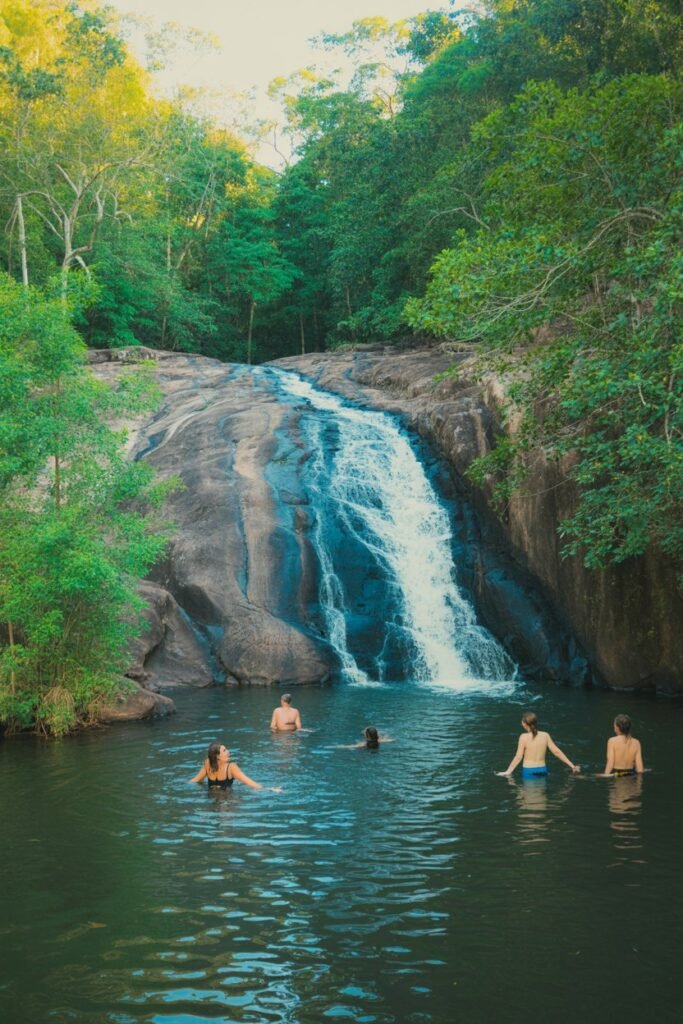
- Families with young children or elderly travelers
- Those with limited mobility
- Visitors who appreciate having amenities like a café
- People looking for a larger swimming area
Of course, the ideal solution is to visit both falls if time permits. Many day-trippers from Darwin manage to see both Florence and Wangi Falls, plus Buley Rockhole, in a single day [SOURCE].
If visiting during the wet season (October-April), it’s worth noting that Wangi Falls is more likely to be closed for swimming due to high water levels and potential crocodile concerns. Florence Falls sometimes remains open when Wangi is closed, making it a more reliable option during this time.
Buley Rockhole guide: access, tiered pools, and best times
Buley Rockhole for first-time visitors: what to expect and plan
While Florence and Wangi Falls tend to get most of the attention, Buley Rockhole offers a unique water experience that many visitors find to be their unexpected favorite spot in Litchfield National Park. Buley Rockhole is very close to Florence Falls, connected by the Shady Creek walking track, and is just a short drive away (allow around 10–15 minutes to drive and park between them).
What Makes Buley Rockhole Special
Unlike traditional waterfall plunge pools, Buley Rockhole features a series of connected pools formed as Florence Creek cascades over smooth rock formations. This creates a natural “staircase” of pools varying in size and depth.
Buley Rockhole is very close to Florence Falls—connected by the 1 km Shady Creek Walk—and it’s about a 10–15 minute drive between the car parks. NT Parks – Litchfield National Park
The rockhole’s unique structure allows visitors to find their perfect spot—whether that’s a shallow, spa-like pool for relaxing, a deeper section for swimming, or a natural “slide” between levels. The water is crystal clear, allowing you to see straight to the sandy bottom [SOURCE].
Many visitors describe Buley as a “natural water park” or “nature’s jacuzzi,” with small cascades creating bubbling, massaging currents in some pools. The surrounding tree canopy provides welcome shade, making it a comfortable place to spend several hours.

Finding Buley Rockhole
Buley Rockhole is located approximately 80 kilometers from Darwin along the same route to Florence Falls. After entering Litchfield National Park, follow the signs to Buley Rockhole—it’s typically one of the first major attractions you’ll reach.
A sealed parking area provides ample space for vehicles, and the rockhole itself is just a short 50-meter walk from the car park. This easy access makes it an ideal first stop on your Litchfield adventure [SOURCE].
Best Times to Visit
Like most attractions in Litchfield, Buley Rockhole is at its best during the dry season (May to September) when water levels are lower and the current is gentler. During this time, the pools are clear and perfect for swimming.
For the most tranquil experience, try to arrive early in the morning (before 9:00 AM) or later in the afternoon (after 3:00 PM) when most tour groups have departed. Weekdays are typically less crowded than weekends when many Darwin locals visit the park.
During the wet season, Buley Rockhole can transform into a rushing torrent and is often closed for swimming due to strong currents and the potential presence of crocodiles. Always check current conditions before planning your visit during this time.
Facilities and Amenities
Buley Rockhole offers basic facilities, including:
- Toilets and changing areas
- Picnic tables and shaded areas
- Information boards about the site’s natural features
- Defined pathways to access different parts of the rockhole
There are no food services at Buley itself, so bring your own refreshments and snacks. Remember to take all trash with you when you leave to help preserve this beautiful natural area.
Preparation Tips
To make the most of your Buley Rockhole experience, consider packing:
- Water shoes or sandals with good grip (the rocks can be slippery)
- Sunscreen (even with tree cover, the tropical sun is intense)
- Insect repellent (especially important during the build-up to the wet season)
- Towels and a change of clothes
- A waterproof bag or container for valuables
- A water bottle to stay hydrated
- A waterproof camera to capture the beautiful scenery
If traveling with children, consider bringing floatation devices for younger swimmers, as some pools can be deeper than they appear. The rockhole’s tiered nature means you can find appropriate depths for different swimming abilities.
Litchfield vs Kakadu: Which for a day trip?
Quick Compare: Litchfield is swim-friendly and compact; Kakadu is vast, cultural, and better as 2–3 days.
Litchfield at a glance
- ~120 km (about 90 minutes) from Darwin; compact loop with multiple waterfalls and swimming holes; most highlights are 2WD-accessible.
- No park entry fee; camping fees apply. Always check seasonal access and swimming safety. NT Parks – Litchfield National Park | Park access and alerts
Kakadu at a glance
- About 3 hours from Darwin to Jabiru/Ubirr; Australia’s largest national park with dual World Heritage status.
- World-class Aboriginal rock art at Ubirr and Burrungkuy (Nourlangie). A Kakadu Parks Pass is required.
- Many marquee sites (e.g., Jim Jim and Twin Falls) require high-clearance 4WD and are typically dry-season only. Best experienced over 2–3 days. Getting to Kakadu | Parks Pass | Culture & rock art | When to visit
Recommendation
- One relaxed swim-focused day: Choose Litchfield.
- Culture-first and okay with a longer drive: A Kakadu day trip gives you a taste of rock art and wetlands, but plan 2–3 days for the full experience. See our guide: Kakadu National Park Guide.
Litchfield National Park day trip from Darwin: itinerary, timing, and transport
Litchfield day trip itinerary from Darwin: route and timing
With proper planning, a day trip to Litchfield National Park from Darwin can encompass all the major highlights while still allowing time to relax and enjoy each location. Here’s a suggested itinerary to help you make the most of your Australian adventure.
Suggested Itinerary
Early Morning (7:00 AM – 8:00 AM)
- Depart Darwin early to maximize your time in the park
- The drive is about 120 kilometres (75 miles) and takes approximately 90 minutes via the Stuart Highway and Batchelor Road. NT Parks – Litchfield National Park
- Consider stopping in the town of Batchelor for coffee or last-minute supplies
Mid-Morning (9:30 AM – 11:00 AM)
- Begin with the Magnetic Termite Mounds — these fascinating structures are best viewed in morning light for photography
- A short boardwalk takes you through the field of termite mounds, with informative signs explaining their north-south orientation
- This stop typically takes 30-45 minutes
Late Morning (11:00 AM – 12:30 PM)
- Head to Buley Rockhole for your first swimming opportunity of the day
- The tiered pools are perfect for a refreshing dip before the day gets too hot
- Allow 1-1.5 hours to fully enjoy this unique spot
Lunch (12:30 PM – 1:30 PM)
- Option 1: Bring a picnic lunch to enjoy at Buley Rockhole’s shaded picnic area
- Option 2: Drive to Wangi Falls for lunch at the café (if you prefer not to carry food)
Early Afternoon (1:30 PM – 3:30 PM)
- Visit Florence Falls — take in the view from the lookout before descending the steps to the plunge pool
- Enjoy swimming at the base of the double waterfall
- For the energetic, consider the 1 km Shady Creek Walk that connects Florence Falls and Buley Rockhole
- Allow 1.5-2 hours for this stop
Mid-Afternoon (3:30 PM – 5:00 PM)
- Drive to Wangi Falls (if you haven’t been there for lunch)
- Swim in the large pool beneath the falls
- If time permits, take the 1.6 km walking track around the falls
- The afternoon light creates beautiful photo opportunities here
Optional Add-on
- Tolmer Falls Lookout — This waterfall isn’t accessible for swimming, but the viewing platform offers spectacular views of the falls cascading into a deep gorge
- This stop requires just 15-20 minutes and is worth including if time allows
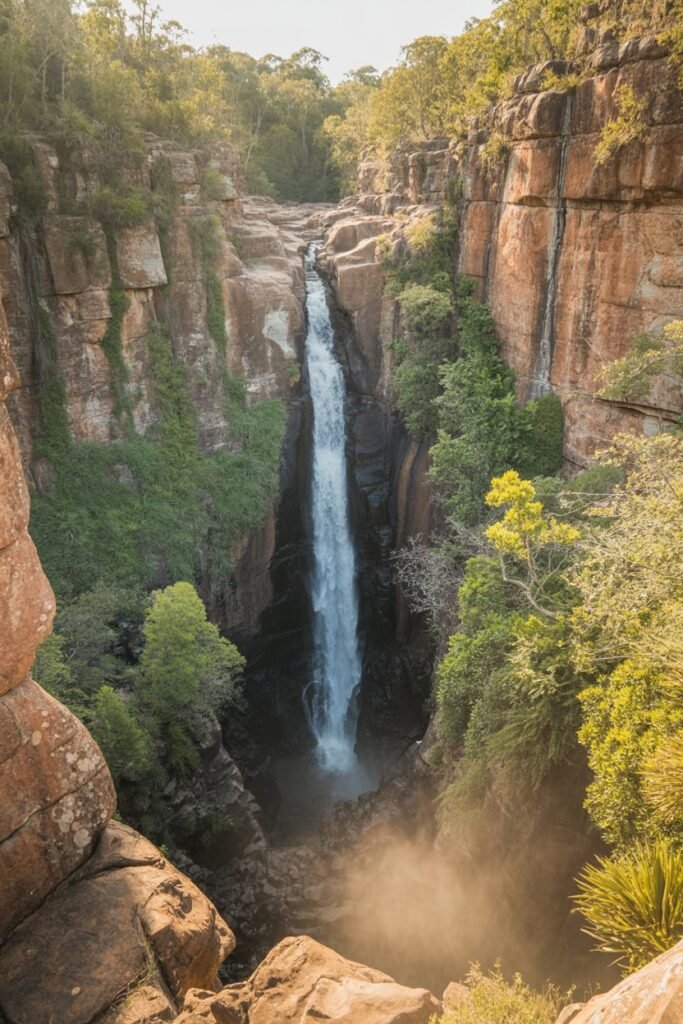
Evening (5:00 PM – 6:30 PM)
- Begin the return journey to Darwin
- Arrive back in the city in time for dinner
This itinerary covers all the main attractions of Litchfield National Park in a logical sequence that minimizes backtracking [SOURCE].
Travel Essentials
What to Pack:
- Swimwear and towels
- Hat, sunglasses, and sunscreen
- Insect repellent
- Comfortable walking shoes and water shoes/sandals for swimming
- At least 2 liters of water per person
- Snacks and lunch (unless planning to eat at Wangi Falls Café)
- Camera
- Cash (mobile reception can be limited for card payments)
- There’s no park entry fee for Litchfield; camping fees apply at designated campgrounds. NT Parks – Litchfield National Park
Best Time of Year:
The dry season (May to September) is undoubtedly the best time to visit Litchfield. During these months:
- All roads and attractions are typically open
- Swimming is safest as water levels are lower and crocodile risk is minimal
- The weather is pleasant with warm days and cooler nights
- June to August offers the most comfortable temperatures [SOURCE]
The wet season (October to April) brings its own beauty with thundering waterfalls and lush vegetation, but be aware that some areas may be closed due to flooding or crocodile management.
Transportation Options
Self-Drive:
Renting a car in Darwin provides the most flexibility for your Litchfield day trip. A standard 2WD is fine for the main sealed-road highlights. The Lost City and the Reynolds River Track require high-clearance 4WD and generally open only in the dry season. Always check current access and road conditions via Park access and alerts, the Litchfield National Park page, and the NT Road Report. Car rental typically ranges from AUD $70 to $120 per day, depending on vehicle and company.
Guided Tours:
If you prefer not to drive, numerous tour operators in Darwin offer day trips to Litchfield. These typically include:
- Hotel pickup and drop-off
- Transportation in air-conditioned vehicles
- Professional guide with information about the park
- Lunch and refreshments
- Visits to all major attractions
Tour prices generally range from AUD $100-150 per person. While slightly more expensive than self-driving, tours offer the advantage of local knowledge and a stress-free experience [SOURCE].
Litchfield National Park FAQs for Top End travelers
Best time to visit Litchfield National Park (Top End seasons and weather)?
The Top End dry season (May–September) is ideal for road access and swimming. Days are warm with low humidity, most roads and tracks are open, and the popular swimming holes are usually open and monitored. In the wet season (October–April), waterfalls boom and the park is lush, but some sites close due to strong currents or crocodile management, and unsealed tracks can be inaccessible. If your priority is swimming and an easy Litchfield National Park day trip from Darwin, plan for the dry; for dramatic flows and fewer crowds, consider the early wet (conditions permitting).
Are Litchfield swimming holes crocodile-safe, and how do wet-season closures work?
Litchfield’s main swimming areas (Florence Falls, Wangi Falls, Buley Rockhole) are surveyed by rangers and only opened when deemed crocodile-safe. Always obey signage and barriers—sites can close quickly in the wet season due to rising water or crocodile risk, with Wangi Falls the most commonly affected. Swim only in designated areas, never dive (submerged rocks), take care on slippery edges, supervise children closely, and stay hydrated. If a waterhole is closed, choose an open alternative rather than entering the water elsewhere.
Can I do a Litchfield National Park day trip from Darwin, and what’s a realistic route and drive time?
Yes, leave Darwin around 7–8 am for a comfortable full day on the sealed Stuart Highway–Batchelor Road route. A classic loop is: Magnetic Termite Mounds (short stop), Buley Rockhole (mid-morning swim), Florence Falls (lookout plus swim or Shady Creek Walk), and Wangi Falls (late-afternoon swim and optional loop track). Add Tolmer Falls lookout if time allows. The drive is about 90 minutes each way, and you’ll be back in Darwin for dinner. This route mirrors many guided options in a typical Darwin Top End travel guide.
Do I need 4WD for Litchfield, and how long is the Darwin drive via sealed roads?
No, 2WD is fine for the major highlights connected by sealed roads. Florence Falls, Wangi Falls, Buley Rockhole, Tolmer Falls, and the Magnetic Termite Mounds are linked by sealed roads suitable for 2WD. A 4WD is required for remote sites like the Lost City or the Reynolds River Track, usually in the dry only. From Darwin, it’s roughly 120 km (about 90 minutes) via Stuart Highway and Batchelor Road. Top up fuel at Batchelor, start early, and expect limited mobile reception in parts of the park.
Which are the best Litchfield swimming spots—Florence vs Wangi vs Buley—and how do they compare for access and families?
For the best swimming holes in Litchfield, each suits different travelers and access needs. Florence Falls has a double cascade and a deep, intimate plunge pool (allow for ~160 steps). Wangi Falls offers a broad lagoon with excellent facilities and easy access—Litchfield National Park day trip from Darwin: itinerary, timing, and transportgreat for families—though it’s more prone to wet-season closures. Buley Rockhole is a chain of tiered pools with varying depths, ideal for lingering and finding a quieter nook. If time allows, visit all three; otherwise, choose Florence for drama, Wangi for convenience, and Buley for variety.

